130/30 Fund Strategies: Analysis and Application
VerifiedAdded on 2020/03/01
|6
|1477
|110
AI Summary
This assignment delves into the world of 130/30 fund strategies. It examines the financial ratios used to evaluate these funds, particularly focusing on Martingale Asset Management's 130/30 structure and its performance. The discussion extends to the CAPM (Capital Asset Pricing Model) and its empirical validity, including the concept of risk anomalies. The assignment also explores the merits of low volatility investment strategies, considering whether a 130/30 structure is an effective approach for implementing them. Finally, it probes the likelihood of risk anomalies persisting in the future.
Contribute Materials
Your contribution can guide someone’s learning journey. Share your
documents today.
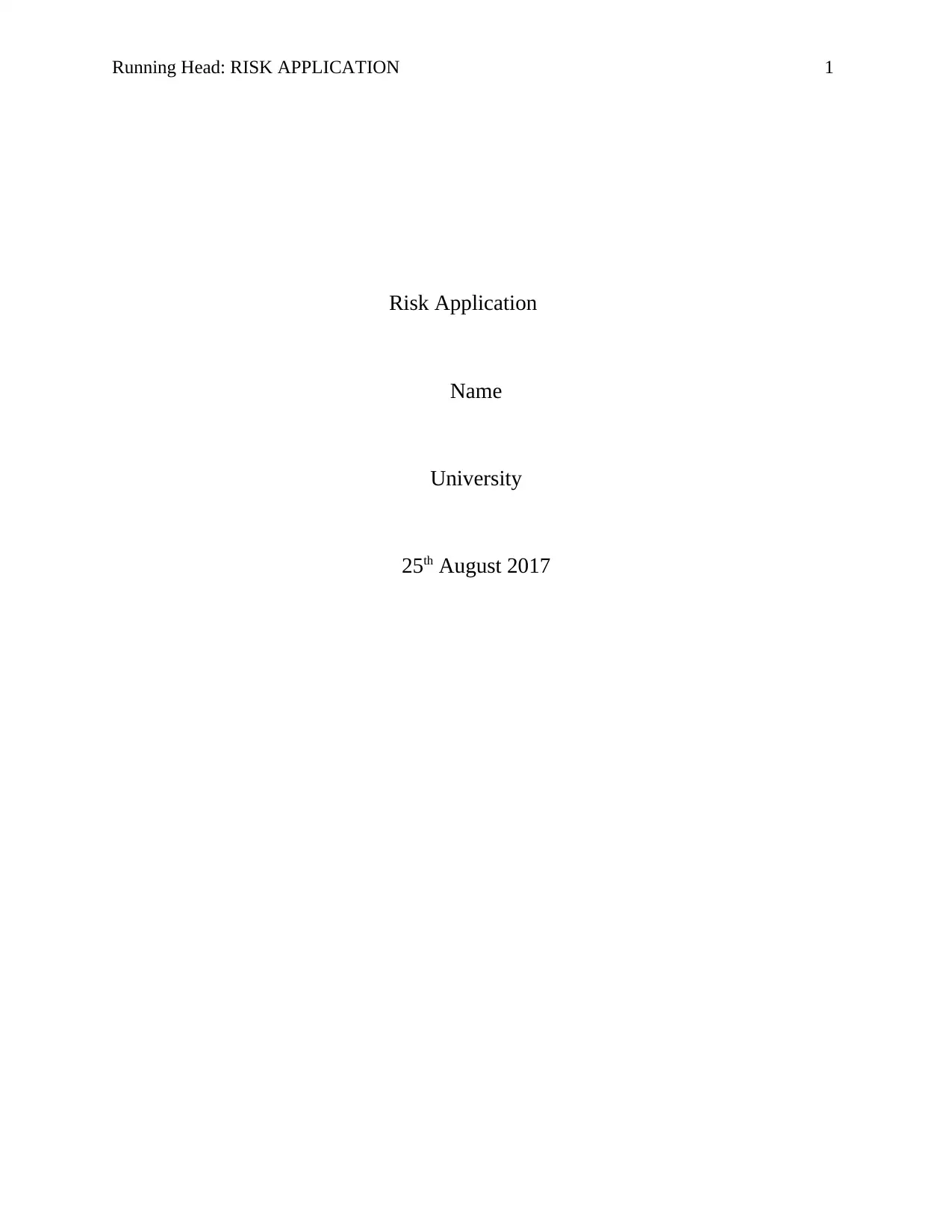
Running Head: RISK APPLICATION 1
Risk Application
Name
University
25th August 2017
Risk Application
Name
University
25th August 2017
Secure Best Marks with AI Grader
Need help grading? Try our AI Grader for instant feedback on your assignments.
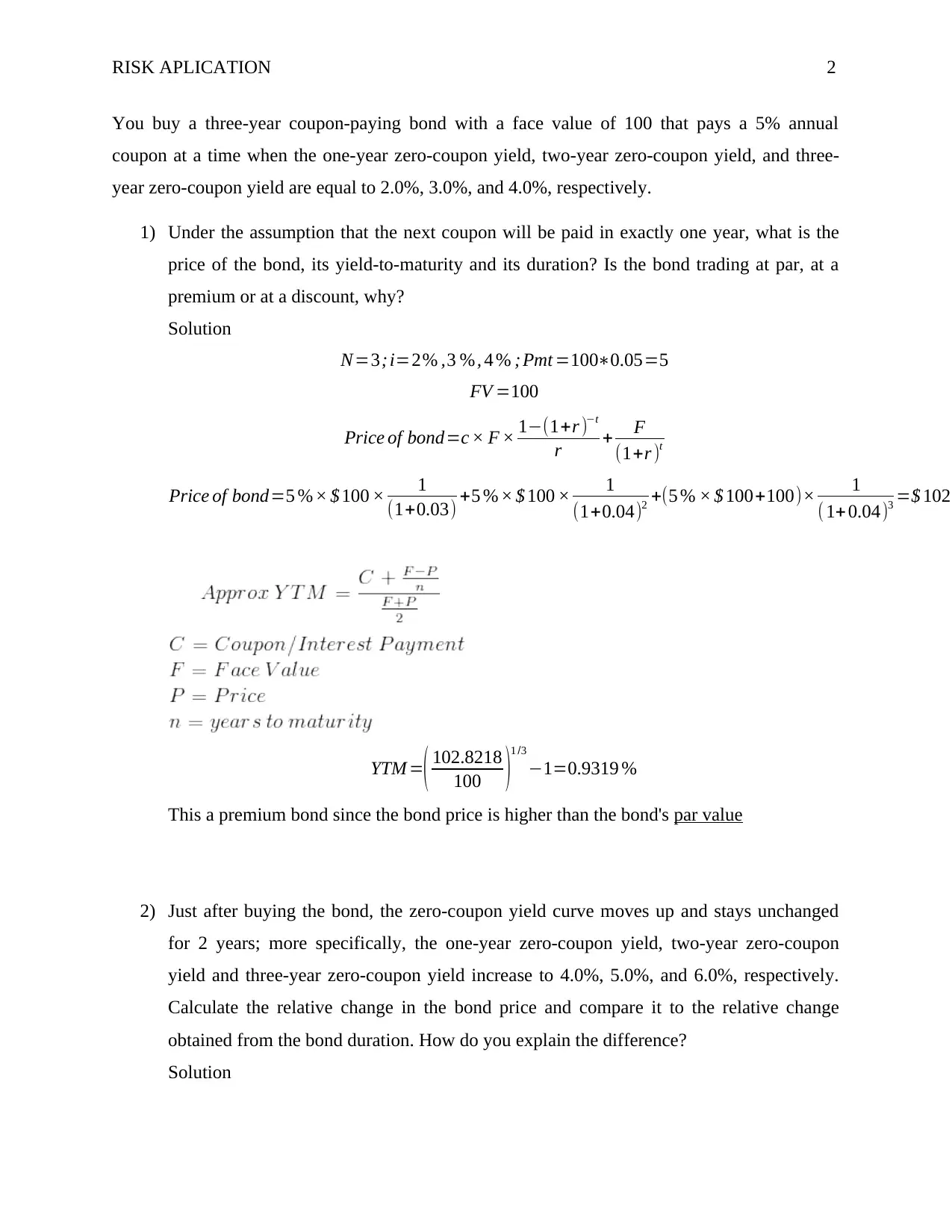
RISK APLICATION 2
You buy a three-year coupon-paying bond with a face value of 100 that pays a 5% annual
coupon at a time when the one-year zero-coupon yield, two-year zero-coupon yield, and three-
year zero-coupon yield are equal to 2.0%, 3.0%, and 4.0%, respectively.
1) Under the assumption that the next coupon will be paid in exactly one year, what is the
price of the bond, its yield-to-maturity and its duration? Is the bond trading at par, at a
premium or at a discount, why?
Solution
N=3; i=2% ,3 %, 4 % ; Pmt =100∗0.05=5
FV =100
Price of bond=c × F × 1−(1+r )−t
r + F
(1+r )t
Price of bond=5 % × $ 100 × 1
(1+0.03) +5 % × $ 100 × 1
(1+0.04)2 +(5 % × $ 100+100)× 1
( 1+0.04)3 =$ 102.
YTM =( 102.8218
100 )
1 /3
−1=0.9319 %
This a premium bond since the bond price is higher than the bond's par value
2) Just after buying the bond, the zero-coupon yield curve moves up and stays unchanged
for 2 years; more specifically, the one-year zero-coupon yield, two-year zero-coupon
yield and three-year zero-coupon yield increase to 4.0%, 5.0%, and 6.0%, respectively.
Calculate the relative change in the bond price and compare it to the relative change
obtained from the bond duration. How do you explain the difference?
Solution
You buy a three-year coupon-paying bond with a face value of 100 that pays a 5% annual
coupon at a time when the one-year zero-coupon yield, two-year zero-coupon yield, and three-
year zero-coupon yield are equal to 2.0%, 3.0%, and 4.0%, respectively.
1) Under the assumption that the next coupon will be paid in exactly one year, what is the
price of the bond, its yield-to-maturity and its duration? Is the bond trading at par, at a
premium or at a discount, why?
Solution
N=3; i=2% ,3 %, 4 % ; Pmt =100∗0.05=5
FV =100
Price of bond=c × F × 1−(1+r )−t
r + F
(1+r )t
Price of bond=5 % × $ 100 × 1
(1+0.03) +5 % × $ 100 × 1
(1+0.04)2 +(5 % × $ 100+100)× 1
( 1+0.04)3 =$ 102.
YTM =( 102.8218
100 )
1 /3
−1=0.9319 %
This a premium bond since the bond price is higher than the bond's par value
2) Just after buying the bond, the zero-coupon yield curve moves up and stays unchanged
for 2 years; more specifically, the one-year zero-coupon yield, two-year zero-coupon
yield and three-year zero-coupon yield increase to 4.0%, 5.0%, and 6.0%, respectively.
Calculate the relative change in the bond price and compare it to the relative change
obtained from the bond duration. How do you explain the difference?
Solution
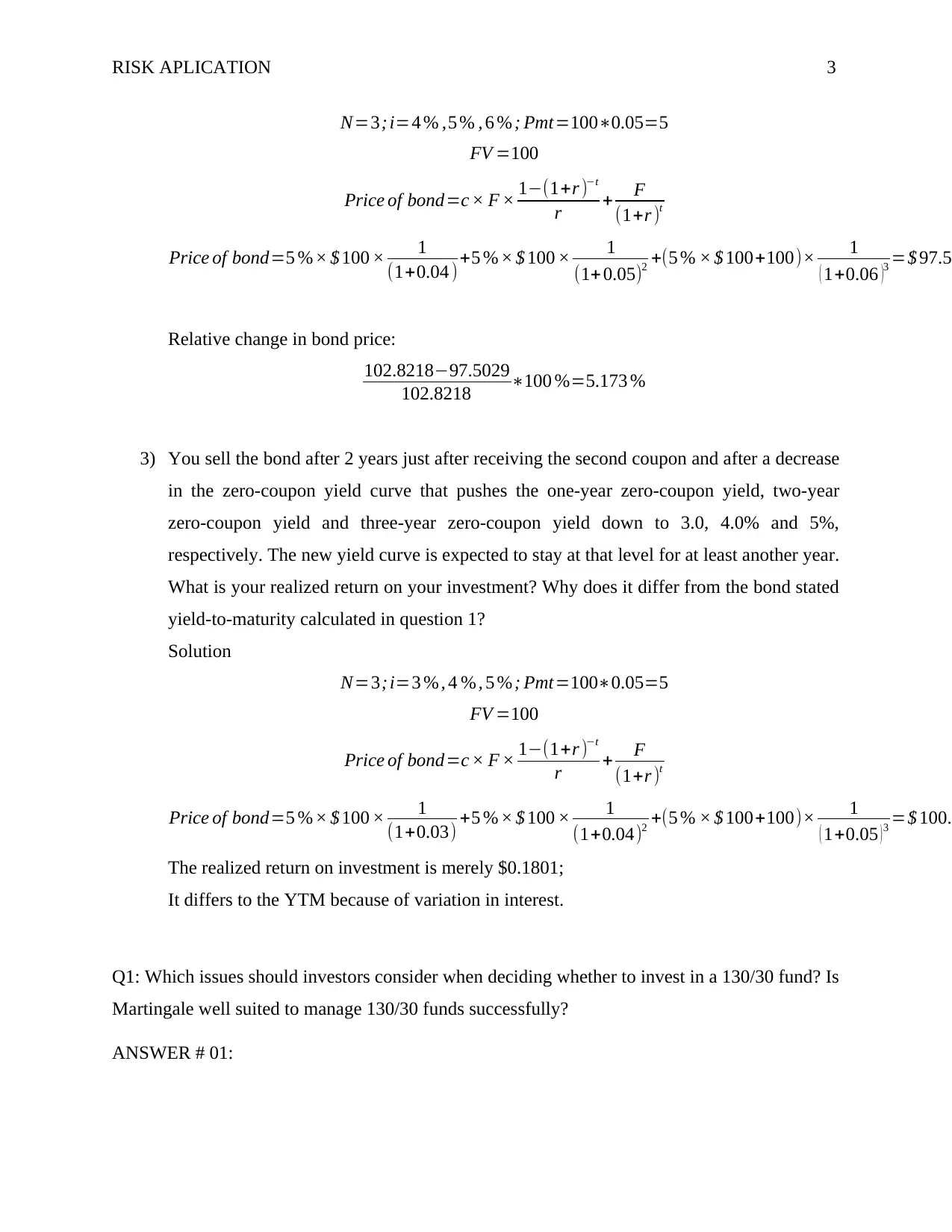
RISK APLICATION 3
N=3; i=4 % ,5 % , 6 %; Pmt=100∗0.05=5
FV =100
Price of bond=c × F × 1−(1+r )−t
r + F
(1+r )t
Price of bond=5 %× $ 100 × 1
(1+0.04 ) +5 % × $ 100 × 1
(1+ 0.05)2 +(5 % × $ 100+100)× 1
( 1+0.06 )3 =$ 97.50
Relative change in bond price:
102.8218−97.5029
102.8218 ∗100 %=5.173 %
3) You sell the bond after 2 years just after receiving the second coupon and after a decrease
in the zero-coupon yield curve that pushes the one-year zero-coupon yield, two-year
zero-coupon yield and three-year zero-coupon yield down to 3.0, 4.0% and 5%,
respectively. The new yield curve is expected to stay at that level for at least another year.
What is your realized return on your investment? Why does it differ from the bond stated
yield-to-maturity calculated in question 1?
Solution
N=3; i=3 % , 4 % , 5 %; Pmt=100∗0.05=5
FV =100
Price of bond=c × F × 1−(1+r )−t
r + F
(1+r )t
Price of bond=5 % × $ 100 × 1
(1+0.03) +5 % × $ 100 × 1
(1+0.04)2 +(5 % × $ 100+100)× 1
( 1+0.05 ) 3 =$ 100.1
The realized return on investment is merely $0.1801;
It differs to the YTM because of variation in interest.
Q1: Which issues should investors consider when deciding whether to invest in a 130/30 fund? Is
Martingale well suited to manage 130/30 funds successfully?
ANSWER # 01:
N=3; i=4 % ,5 % , 6 %; Pmt=100∗0.05=5
FV =100
Price of bond=c × F × 1−(1+r )−t
r + F
(1+r )t
Price of bond=5 %× $ 100 × 1
(1+0.04 ) +5 % × $ 100 × 1
(1+ 0.05)2 +(5 % × $ 100+100)× 1
( 1+0.06 )3 =$ 97.50
Relative change in bond price:
102.8218−97.5029
102.8218 ∗100 %=5.173 %
3) You sell the bond after 2 years just after receiving the second coupon and after a decrease
in the zero-coupon yield curve that pushes the one-year zero-coupon yield, two-year
zero-coupon yield and three-year zero-coupon yield down to 3.0, 4.0% and 5%,
respectively. The new yield curve is expected to stay at that level for at least another year.
What is your realized return on your investment? Why does it differ from the bond stated
yield-to-maturity calculated in question 1?
Solution
N=3; i=3 % , 4 % , 5 %; Pmt=100∗0.05=5
FV =100
Price of bond=c × F × 1−(1+r )−t
r + F
(1+r )t
Price of bond=5 % × $ 100 × 1
(1+0.03) +5 % × $ 100 × 1
(1+0.04)2 +(5 % × $ 100+100)× 1
( 1+0.05 ) 3 =$ 100.1
The realized return on investment is merely $0.1801;
It differs to the YTM because of variation in interest.
Q1: Which issues should investors consider when deciding whether to invest in a 130/30 fund? Is
Martingale well suited to manage 130/30 funds successfully?
ANSWER # 01:
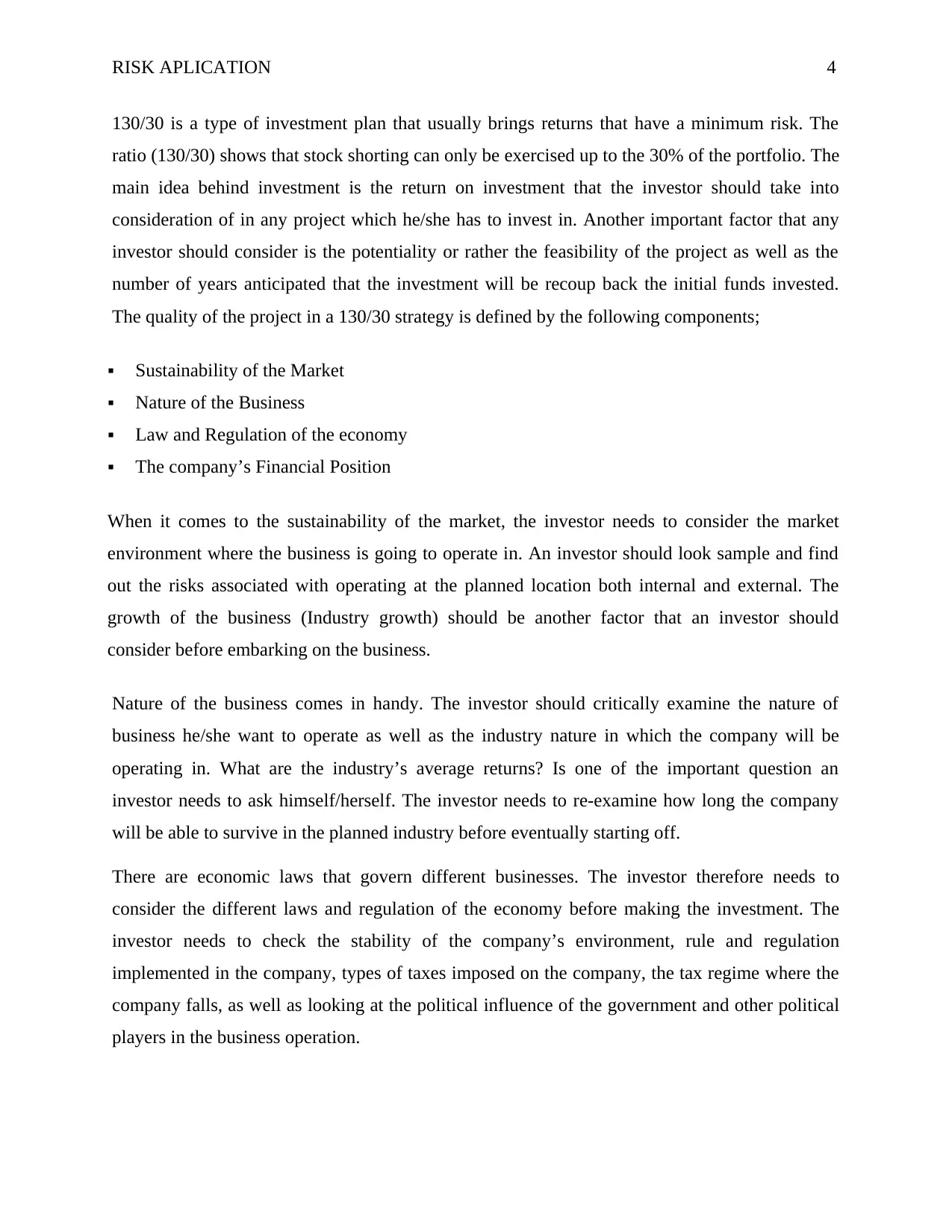
RISK APLICATION 4
130/30 is a type of investment plan that usually brings returns that have a minimum risk. The
ratio (130/30) shows that stock shorting can only be exercised up to the 30% of the portfolio. The
main idea behind investment is the return on investment that the investor should take into
consideration of in any project which he/she has to invest in. Another important factor that any
investor should consider is the potentiality or rather the feasibility of the project as well as the
number of years anticipated that the investment will be recoup back the initial funds invested.
The quality of the project in a 130/30 strategy is defined by the following components;
Sustainability of the Market
Nature of the Business
Law and Regulation of the economy
The company’s Financial Position
When it comes to the sustainability of the market, the investor needs to consider the market
environment where the business is going to operate in. An investor should look sample and find
out the risks associated with operating at the planned location both internal and external. The
growth of the business (Industry growth) should be another factor that an investor should
consider before embarking on the business.
Nature of the business comes in handy. The investor should critically examine the nature of
business he/she want to operate as well as the industry nature in which the company will be
operating in. What are the industry’s average returns? Is one of the important question an
investor needs to ask himself/herself. The investor needs to re-examine how long the company
will be able to survive in the planned industry before eventually starting off.
There are economic laws that govern different businesses. The investor therefore needs to
consider the different laws and regulation of the economy before making the investment. The
investor needs to check the stability of the company’s environment, rule and regulation
implemented in the company, types of taxes imposed on the company, the tax regime where the
company falls, as well as looking at the political influence of the government and other political
players in the business operation.
130/30 is a type of investment plan that usually brings returns that have a minimum risk. The
ratio (130/30) shows that stock shorting can only be exercised up to the 30% of the portfolio. The
main idea behind investment is the return on investment that the investor should take into
consideration of in any project which he/she has to invest in. Another important factor that any
investor should consider is the potentiality or rather the feasibility of the project as well as the
number of years anticipated that the investment will be recoup back the initial funds invested.
The quality of the project in a 130/30 strategy is defined by the following components;
Sustainability of the Market
Nature of the Business
Law and Regulation of the economy
The company’s Financial Position
When it comes to the sustainability of the market, the investor needs to consider the market
environment where the business is going to operate in. An investor should look sample and find
out the risks associated with operating at the planned location both internal and external. The
growth of the business (Industry growth) should be another factor that an investor should
consider before embarking on the business.
Nature of the business comes in handy. The investor should critically examine the nature of
business he/she want to operate as well as the industry nature in which the company will be
operating in. What are the industry’s average returns? Is one of the important question an
investor needs to ask himself/herself. The investor needs to re-examine how long the company
will be able to survive in the planned industry before eventually starting off.
There are economic laws that govern different businesses. The investor therefore needs to
consider the different laws and regulation of the economy before making the investment. The
investor needs to check the stability of the company’s environment, rule and regulation
implemented in the company, types of taxes imposed on the company, the tax regime where the
company falls, as well as looking at the political influence of the government and other political
players in the business operation.
Secure Best Marks with AI Grader
Need help grading? Try our AI Grader for instant feedback on your assignments.
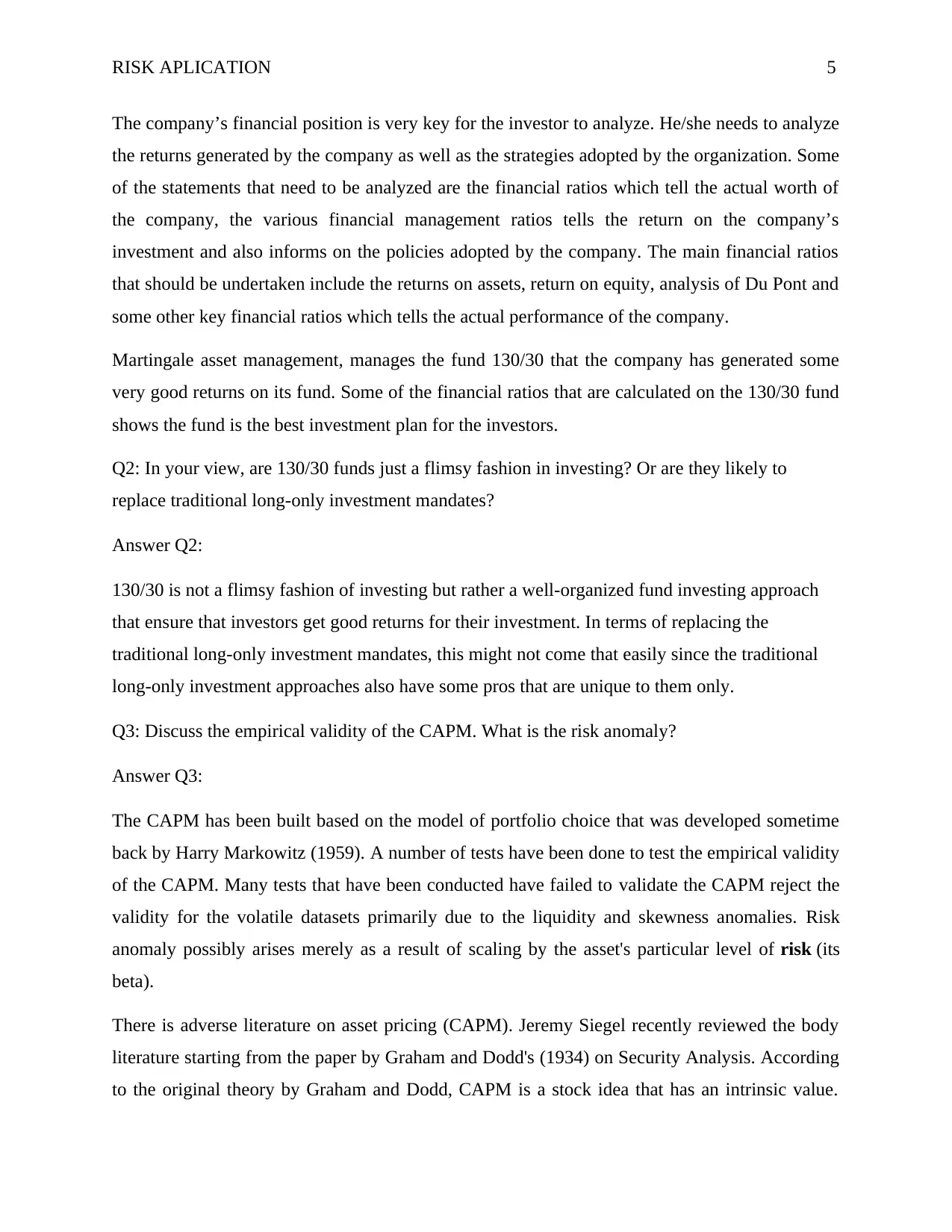
RISK APLICATION 5
The company’s financial position is very key for the investor to analyze. He/she needs to analyze
the returns generated by the company as well as the strategies adopted by the organization. Some
of the statements that need to be analyzed are the financial ratios which tell the actual worth of
the company, the various financial management ratios tells the return on the company’s
investment and also informs on the policies adopted by the company. The main financial ratios
that should be undertaken include the returns on assets, return on equity, analysis of Du Pont and
some other key financial ratios which tells the actual performance of the company.
Martingale asset management, manages the fund 130/30 that the company has generated some
very good returns on its fund. Some of the financial ratios that are calculated on the 130/30 fund
shows the fund is the best investment plan for the investors.
Q2: In your view, are 130/30 funds just a flimsy fashion in investing? Or are they likely to
replace traditional long-only investment mandates?
Answer Q2:
130/30 is not a flimsy fashion of investing but rather a well-organized fund investing approach
that ensure that investors get good returns for their investment. In terms of replacing the
traditional long-only investment mandates, this might not come that easily since the traditional
long-only investment approaches also have some pros that are unique to them only.
Q3: Discuss the empirical validity of the CAPM. What is the risk anomaly?
Answer Q3:
The CAPM has been built based on the model of portfolio choice that was developed sometime
back by Harry Markowitz (1959). A number of tests have been done to test the empirical validity
of the CAPM. Many tests that have been conducted have failed to validate the CAPM reject the
validity for the volatile datasets primarily due to the liquidity and skewness anomalies. Risk
anomaly possibly arises merely as a result of scaling by the asset's particular level of risk (its
beta).
There is adverse literature on asset pricing (CAPM). Jeremy Siegel recently reviewed the body
literature starting from the paper by Graham and Dodd's (1934) on Security Analysis. According
to the original theory by Graham and Dodd, CAPM is a stock idea that has an intrinsic value.
The company’s financial position is very key for the investor to analyze. He/she needs to analyze
the returns generated by the company as well as the strategies adopted by the organization. Some
of the statements that need to be analyzed are the financial ratios which tell the actual worth of
the company, the various financial management ratios tells the return on the company’s
investment and also informs on the policies adopted by the company. The main financial ratios
that should be undertaken include the returns on assets, return on equity, analysis of Du Pont and
some other key financial ratios which tells the actual performance of the company.
Martingale asset management, manages the fund 130/30 that the company has generated some
very good returns on its fund. Some of the financial ratios that are calculated on the 130/30 fund
shows the fund is the best investment plan for the investors.
Q2: In your view, are 130/30 funds just a flimsy fashion in investing? Or are they likely to
replace traditional long-only investment mandates?
Answer Q2:
130/30 is not a flimsy fashion of investing but rather a well-organized fund investing approach
that ensure that investors get good returns for their investment. In terms of replacing the
traditional long-only investment mandates, this might not come that easily since the traditional
long-only investment approaches also have some pros that are unique to them only.
Q3: Discuss the empirical validity of the CAPM. What is the risk anomaly?
Answer Q3:
The CAPM has been built based on the model of portfolio choice that was developed sometime
back by Harry Markowitz (1959). A number of tests have been done to test the empirical validity
of the CAPM. Many tests that have been conducted have failed to validate the CAPM reject the
validity for the volatile datasets primarily due to the liquidity and skewness anomalies. Risk
anomaly possibly arises merely as a result of scaling by the asset's particular level of risk (its
beta).
There is adverse literature on asset pricing (CAPM). Jeremy Siegel recently reviewed the body
literature starting from the paper by Graham and Dodd's (1934) on Security Analysis. According
to the original theory by Graham and Dodd, CAPM is a stock idea that has an intrinsic value.
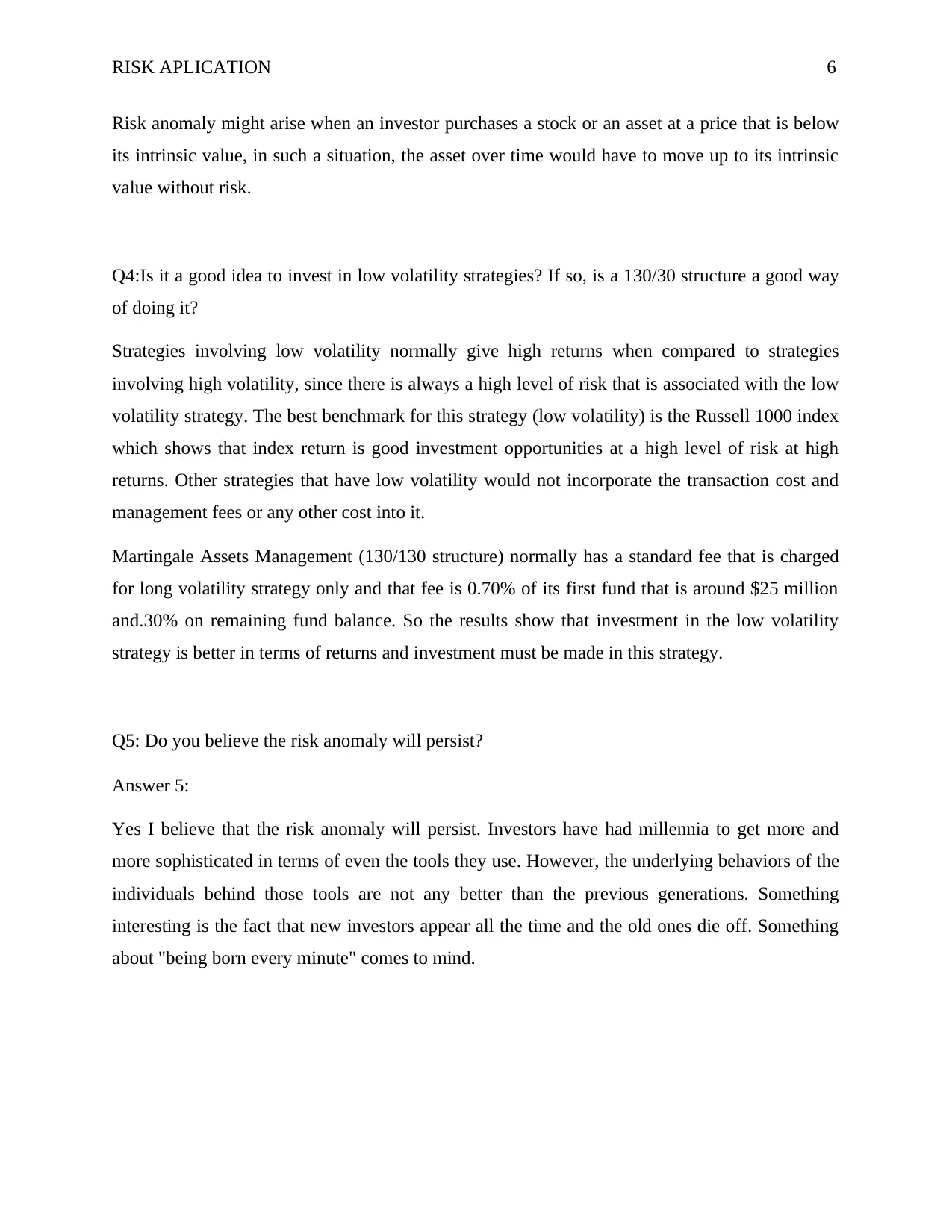
RISK APLICATION 6
Risk anomaly might arise when an investor purchases a stock or an asset at a price that is below
its intrinsic value, in such a situation, the asset over time would have to move up to its intrinsic
value without risk.
Q4:Is it a good idea to invest in low volatility strategies? If so, is a 130/30 structure a good way
of doing it?
Strategies involving low volatility normally give high returns when compared to strategies
involving high volatility, since there is always a high level of risk that is associated with the low
volatility strategy. The best benchmark for this strategy (low volatility) is the Russell 1000 index
which shows that index return is good investment opportunities at a high level of risk at high
returns. Other strategies that have low volatility would not incorporate the transaction cost and
management fees or any other cost into it.
Martingale Assets Management (130/130 structure) normally has a standard fee that is charged
for long volatility strategy only and that fee is 0.70% of its first fund that is around $25 million
and.30% on remaining fund balance. So the results show that investment in the low volatility
strategy is better in terms of returns and investment must be made in this strategy.
Q5: Do you believe the risk anomaly will persist?
Answer 5:
Yes I believe that the risk anomaly will persist. Investors have had millennia to get more and
more sophisticated in terms of even the tools they use. However, the underlying behaviors of the
individuals behind those tools are not any better than the previous generations. Something
interesting is the fact that new investors appear all the time and the old ones die off. Something
about "being born every minute" comes to mind.
Risk anomaly might arise when an investor purchases a stock or an asset at a price that is below
its intrinsic value, in such a situation, the asset over time would have to move up to its intrinsic
value without risk.
Q4:Is it a good idea to invest in low volatility strategies? If so, is a 130/30 structure a good way
of doing it?
Strategies involving low volatility normally give high returns when compared to strategies
involving high volatility, since there is always a high level of risk that is associated with the low
volatility strategy. The best benchmark for this strategy (low volatility) is the Russell 1000 index
which shows that index return is good investment opportunities at a high level of risk at high
returns. Other strategies that have low volatility would not incorporate the transaction cost and
management fees or any other cost into it.
Martingale Assets Management (130/130 structure) normally has a standard fee that is charged
for long volatility strategy only and that fee is 0.70% of its first fund that is around $25 million
and.30% on remaining fund balance. So the results show that investment in the low volatility
strategy is better in terms of returns and investment must be made in this strategy.
Q5: Do you believe the risk anomaly will persist?
Answer 5:
Yes I believe that the risk anomaly will persist. Investors have had millennia to get more and
more sophisticated in terms of even the tools they use. However, the underlying behaviors of the
individuals behind those tools are not any better than the previous generations. Something
interesting is the fact that new investors appear all the time and the old ones die off. Something
about "being born every minute" comes to mind.
1 out of 6
Related Documents
Your All-in-One AI-Powered Toolkit for Academic Success.
+13062052269
info@desklib.com
Available 24*7 on WhatsApp / Email
![[object Object]](/_next/static/media/star-bottom.7253800d.svg)
Unlock your academic potential
© 2024 | Zucol Services PVT LTD | All rights reserved.





